Introduction to the Rosemary Water Recipe
In a world where natural remedies are making a powerful comeback, the rosemary water recipe has earned its spotlight as a versatile elixir for hair care, skin care, and overall wellness. Known for its anti-inflammatory and antioxidant properties, this simple herbal infusion isn’t just a trend—it’s a centuries-old remedy making a modern-day resurgence. But how exactly do you prepare it? What benefits can you expect? And how can you maximize its effects?
In this guide, we’ll break down the rosemary water recipe, share step-by-step instructions, highlight its incredible benefits, and clear up common misconceptions. Whether you’re looking to strengthen your hair, nourish your skin, or simply incorporate more natural solutions into your routine, you’re in the right place. Let’s dive into Part 1 and uncover the fundamentals of this herbal powerhouse.
Table of Contents
The Growing Popularity of Rosemary Water
Why has rosemary water gained such momentum recently? For starters, people are becoming more conscious of what they apply to their bodies. Synthetic chemicals in commercial hair and skin care products often come with a list of side effects. In contrast, rosemary water offers an all-natural alternative packed with antioxidants and anti-inflammatory agents.
Additionally, social media platforms have played a significant role in spreading awareness. Videos showcasing rosemary water recipes have gone viral, with users reporting thicker hair, reduced dandruff, and even improved skin texture after regular use.
But here’s the kicker—it’s incredibly easy to make and costs almost nothing compared to store-bought treatments.
The Importance of Rosemary Water in Modern Wellness
Natural remedies aren’t just about avoiding chemicals—they’re about reconnecting with time-tested traditions. Rosemary water isn’t just water infused with an herb; it’s a potent botanical tonic teeming with compounds like carbonic acid and rosmarinic acid.
These active ingredients contribute to:
- Improved scalp circulation.
- Reduced inflammation.
- Stronger hair follicles.
- A healthier scalp environment.
Plus, rosemary water isn’t limited to hair care. It can act as a facial toner, a stress reliever, and even a natural room spray.
What You’ll Learn in This Guide
Throughout this article, we’ll cover:
- How to prepare a simple yet effective rosemary water recipe.
- The science behind its benefits.
- Practical ways to incorporate it into your routine.
- Common mistakes and how to avoid them.
So, whether you’re here to revitalize your hair, pamper your skin, or simply explore a new DIY project, you’re in for a treat. Stay with us as we uncover the magic behind this ancient herbal remedy.
What is Rosemary Water?
Understanding Rosemary Water

At its core, rosemary water is a simple infusion made by steeping fresh or dried rosemary leaves in water. Yet, don’t let its simplicity fool you—this herbal elixir packs a powerful punch. Derived from the Rosmarinus officinalis plant, rosemary has long been cherished in traditional medicine, skincare rituals, and culinary delights.
When boiled or steeped, rosemary releases its bioactive compounds into the water, creating a fragrant and therapeutic tonic. These compounds, including rosmarinic acid and carnosic acid, are known for their antioxidant and anti-inflammatory properties.
But what sets rosemary water apart is its versatility. It can be used as a hair rinse, facial toner, herbal mist, or even a stress relief spray. Each use offers a unique benefit, from promoting scalp health to calming irritated skin.
Historical Uses of Rosemary Water
Historically, rosemary was more than just an aromatic herb—it was a symbol of memory, protection, and healing. Ancient Greeks and Romans used rosemary water in sacred rituals and therapeutic practices. Monks in medieval times grew rosemary in monastery gardens, believing it could cure ailments and enhance cognitive function.
In folk medicine, rosemary water was often used as:
- A hair tonic to prevent baldness.
- A facial rinse for glowing skin.
- A digestive aid to soothe stomach issues.
Today, these historical uses have transitioned into modern wellness practices, supported by emerging scientific studies.
Why Rosemary Water is Gaining Attention Today
In the era of clean beauty and sustainable living, rosemary water has emerged as a favorite among DIY enthusiasts and natural health advocates. But why?
- Affordability: A homemade rosemary water recipe costs next to nothing.
- Accessibility: Fresh rosemary is widely available, even in grocery stores.
- Effectiveness: Its benefits are backed by both traditional wisdom and scientific research.
- Natural Alternative: It’s free from harsh chemicals often found in commercial products.
The rise of social media has also played a role. Platforms like Instagram and TikTok are flooded with videos showcasing jaw-dropping before-and-after results from regular rosemary water use.
As we move forward, it’s clear that rosemary water isn’t just a fad—it’s a timeless remedy making a well-deserved comeback.
How Rosemary Water Differs from Rosemary Oil
While both rosemary water and rosemary oil are derived from the same plant, they serve slightly different purposes.
| Aspect | Rosemary Water | Rosemary Oil |
| Extraction Method | Boiling or steeping leaves in water | Steam distillation |
| Consistency | Light, watery | Thick, concentrated |
| Primary Use | Hair rinse, facial toner | Scalp massage, hair growth serum |
| Shelf Life | 1–2 weeks (refrigerated) | Several months |
In short, rosemary water is more diluted and suitable for frequent use, while rosemary oil is highly concentrated and often requires dilution before application.
Ingredients for Rosemary Water Recipe
Key Ingredients for a Basic Rosemary Water Recipe
Creating your rosemary water recipe at home is delightfully simple. You’ll need just a few key ingredients, most of which you might already have in your kitchen.
- Fresh Rosemary Sprigs: Ideally, use organic rosemary to avoid pesticides. Fresh sprigs are more aromatic, but dried rosemary can also work.
- Distilled Water: While tap water is fine, distilled water ensures purity, preventing unwanted minerals from interfering with the infusion.
- Optional Additions: Depending on your goals, you can enhance your rosemary water with:
- Cloves (for antimicrobial benefits).
- Lavender oil (for relaxation).
- Peppermint oil (for scalp stimulation).
Tools Needed for Preparing Rosemary Water
To prepare your rosemary water recipe, make sure you have these tools handy:
- Medium-sized Pot: For boiling the water.
- Strainer: To separate the rosemary sprigs from the infused water.
- Spray Bottle or Mason Jar: For easy application and storage.
- Measuring Cup: To ensure accurate water proportions.
Pro tip: If you’re planning to use rosemary water as a spray, opt for a glass spray bottle to avoid chemical leaching from plastic containers.
Choosing the Best Rosemary for Your Recipe
Not all rosemary is created equal! Here’s how to choose the best variety for your rosemary water recipe:
- Fresh vs. Dried: Fresh rosemary releases more natural oils, while dried rosemary is more concentrated.
- Organic Options: Always choose organic to avoid pesticides.
- Scent Test: Fresh rosemary should have a strong, herbal aroma. If it smells weak, it may have lost its potency.
If you don’t have access to fresh rosemary, dried rosemary leaves from a reputable herbal supplier can also deliver excellent results.
Common Questions About Ingredients
- Can I use tap water instead of distilled water?
- Yes, but distilled water is preferable to avoid minerals that might affect the infusion.
- How many rosemary sprigs do I need?
- Generally, 3–4 sprigs per 2 cups of water are ideal.
- Can I mix essential oils into rosemary water?
- Absolutely! Oils like lavender or peppermint can enhance the infusion’s benefits.
For a deeper scientific dive into rosemary’s benefits, check out this scientific study on rosemary extract for hair growth from PubMed.
Step-by-Step Rosemary Water Recipe
How to Make Rosemary Water
Creating your rosemary water recipe at home is not only simple but also incredibly rewarding. Whether you’re using it for hair care, skin care, or relaxation, this step-by-step guide ensures you’ll get the best results every time.
Step 1: Boiling the Water
Start by pouring about 2 cups (470 mL) of distilled water into a medium-sized pot. Place the pot on the stove and bring the water to a rolling boil over medium-high heat.
- Why distilled water? It’s free from minerals and contaminants that could reduce the infusion’s effectiveness.
- Tip: Avoid boiling water at excessively high heat, as it may break down some of the rosemary’s beneficial compounds.
Once the water reaches a rolling boil, reduce the heat to medium-low.
Step 2: Adding Rosemary Sprigs
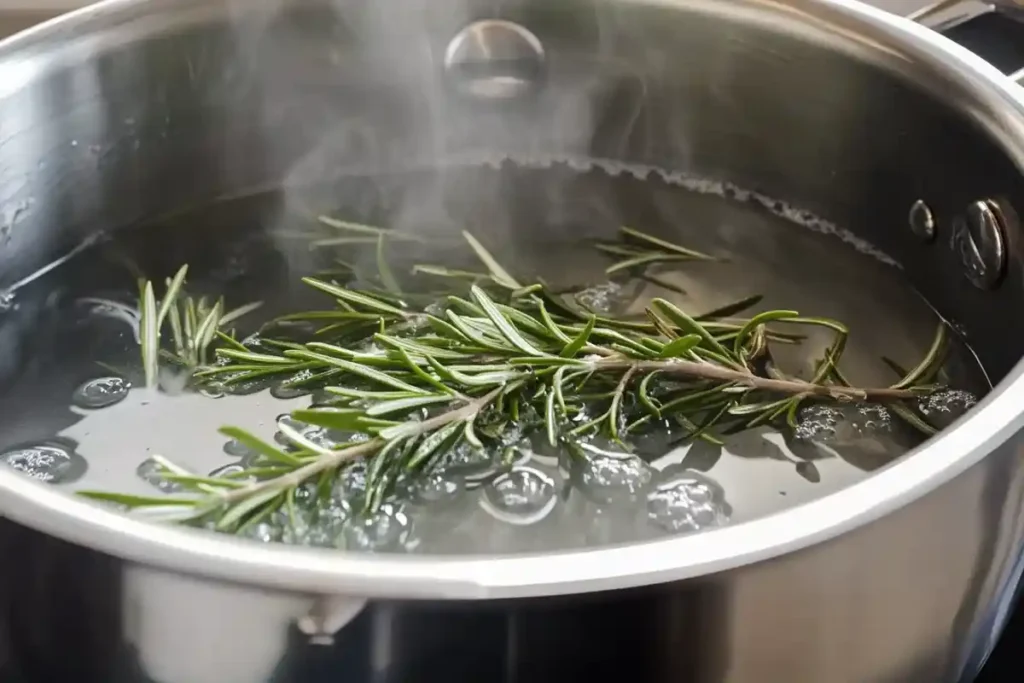
Add 3–4 fresh rosemary sprigs directly into the simmering water. If you’re using dried rosemary, add about 2 tablespoons.
- Cover the pot with a lid to trap the essential oils.
- Allow the rosemary to simmer gently for about 15–20 minutes.
During this time, the water will begin to take on an amber hue and a fresh herbal aroma.
Want to explore more homemade recipes? Learn how to create a sourdough starter from scratch for another simple and beneficial kitchen project.
Optional Additions: For an extra boost, consider adding:
- 1 teaspoon of whole cloves (for antimicrobial properties).
- A few drops of lavender or peppermint essential oil.
Step 3: Cooling and Straining the Mixture
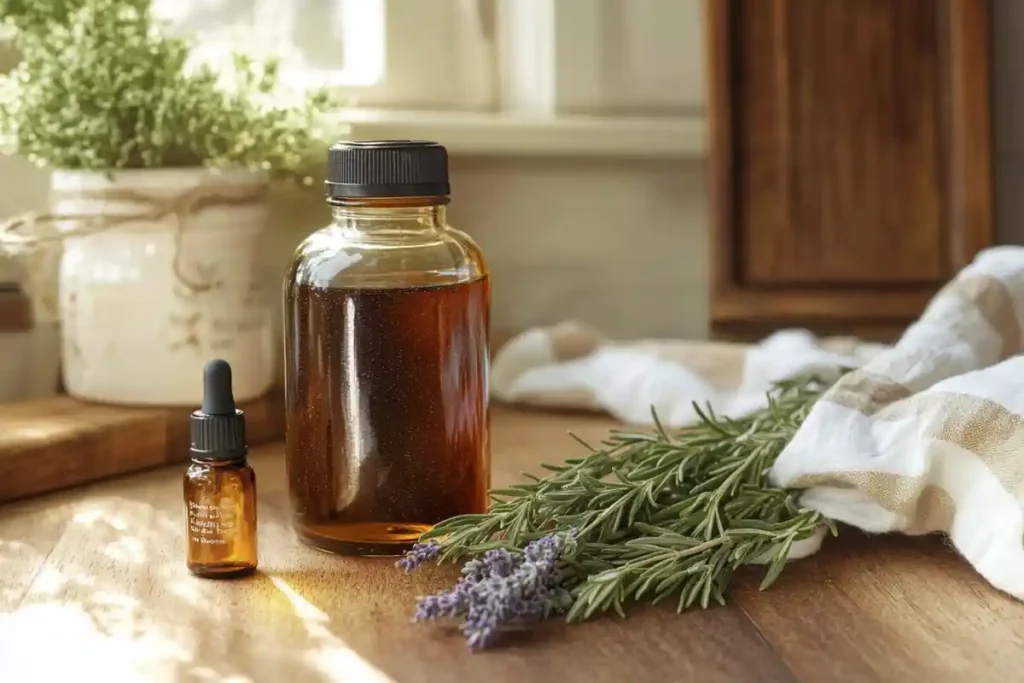
After simmering, remove the pot from the heat and let it cool for at least 30 minutes. This allows the rosemary to continue infusing into the water.
Once the mixture is cool to the touch:
- Use a fine-mesh strainer to separate the rosemary sprigs from the water.
- Pour the strained rosemary water into a clean spray bottle or a sterilized mason jar.
Step 4: Storing Your Rosemary Water
Proper storage ensures the longevity of your infusion:
- Store the rosemary water in the refrigerator.
- Use within 1–2 weeks for optimal freshness.
Pro Tip: Label your container with the preparation date to track its freshness.
Optional Enhancements for Your Rosemary Water Recipe
Want to customize your rosemary water recipe? Here are a few creative tweaks:
- Add a few drops of rose water for an extra floral touch.
- Infuse with green tea leaves for added antioxidants.
- Mix in apple cider vinegar for a clarifying scalp rinse.
Now that you’ve mastered the recipe, let’s move on to the best ways to use rosemary water effectively!
How to Use Rosemary Water
How to Apply Rosemary Water for Hair Growt
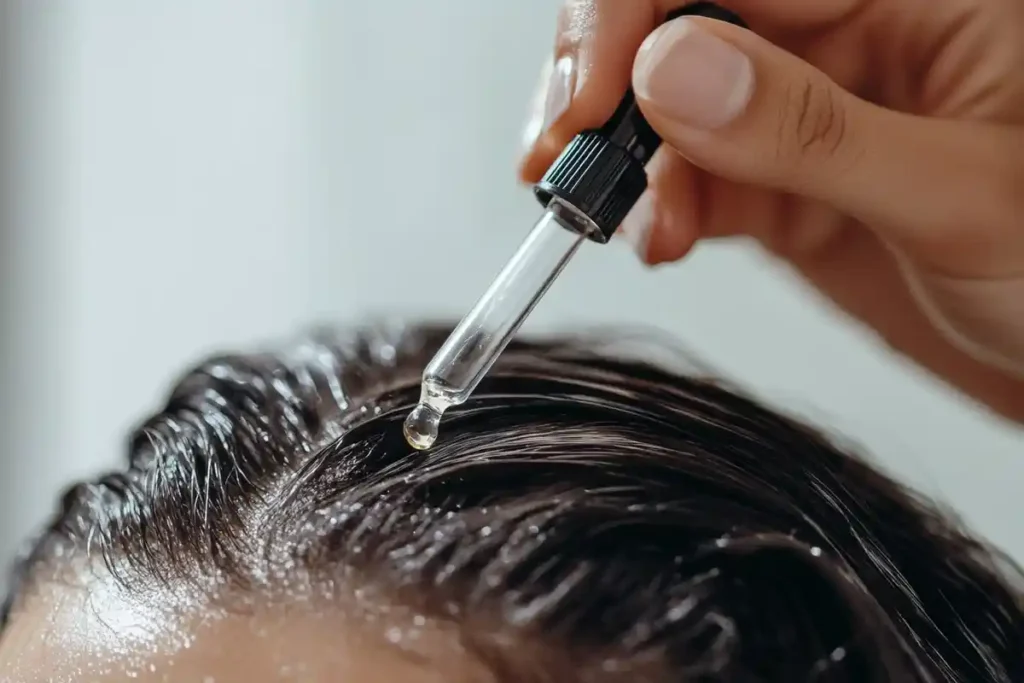
One of the most popular uses of rosemary water is for hair care, particularly for promoting hair growth and reducing dandruff. Here’s how to do it effectively:
- Step 1: Part your hair into sections for better coverage.
- Step 2: Spray the rosemary water directly onto your scalp.
- Step 3: Use your fingertips to massage the scalp in small circular motions.
- Step 4: Leave it on your hair for at least 15–30 minutes.
- Step 5: You can choose to rinse it out or leave it in for deeper absorption.
Frequency: Use 2–3 times per week for visible results.
Pro Tip: Apply rosemary water after showering when your scalp is clean and free from buildup.
Using Rosemary Water as a Hair Rinse
Another effective method for incorporating rosemary water into your hair routine is as a final rinse:
- Wash your hair with shampoo and conditioner as usual.
- After rinsing out your conditioner, pour or spray rosemary water over your scalp and hair.
- Allow it to sit for 5–10 minutes.
- Rinse with cool water or leave it in for added benefits.
This method leaves your hair feeling soft, shiny and invigorated.
How Often Should You Use Rosemary Water?
You might be wondering: Can I use rosemary water every day?
- For most people, applying 2–3 times per week is sufficient.
- However, if you have a sensitive scalp, start with once a week to monitor your skin’s reaction.
- For daily use, consider diluting the rosemary water slightly.
Consistency is key! Hair growth isn’t instant, and it may take 2–6 months to see noticeable results.
Other Uses of Rosemary Water
Rosemary water isn’t just for hair—it has a variety of applications:
- Facial Toner: Spray it onto a cotton pad and apply it to your face for a refreshing, natural toner.
- Room Mist: Use it as a natural air freshener to create a calming atmosphere.
- Stress Relief Spray: The herb’s aroma is known to reduce stress and improve focus.
What to Expect from Regular Use of Rosemary Water
When used consistently, rosemary water can deliver a range of benefits:
- Improved scalp health.
- Reduced dandruff and flakiness.
- Shinier, healthier-looking hair.
- Strengthened hair follicles, reducing breakage.
Enhance Results with Rosemary Oil
For even better results, pair rosemary water with rosemary oil:
- Mix a few drops of rosemary oil with a carrier oil (like coconut or jojoba oil).
- Massage it into your scalp after applying rosemary water.
If you’re curious about the scientific benefits of rosemary for hair, check out this comprehensive guide on Health benefits of Rosemary for Hair and Scalp from Healthline.
Advanced Rosemary Water Recipes
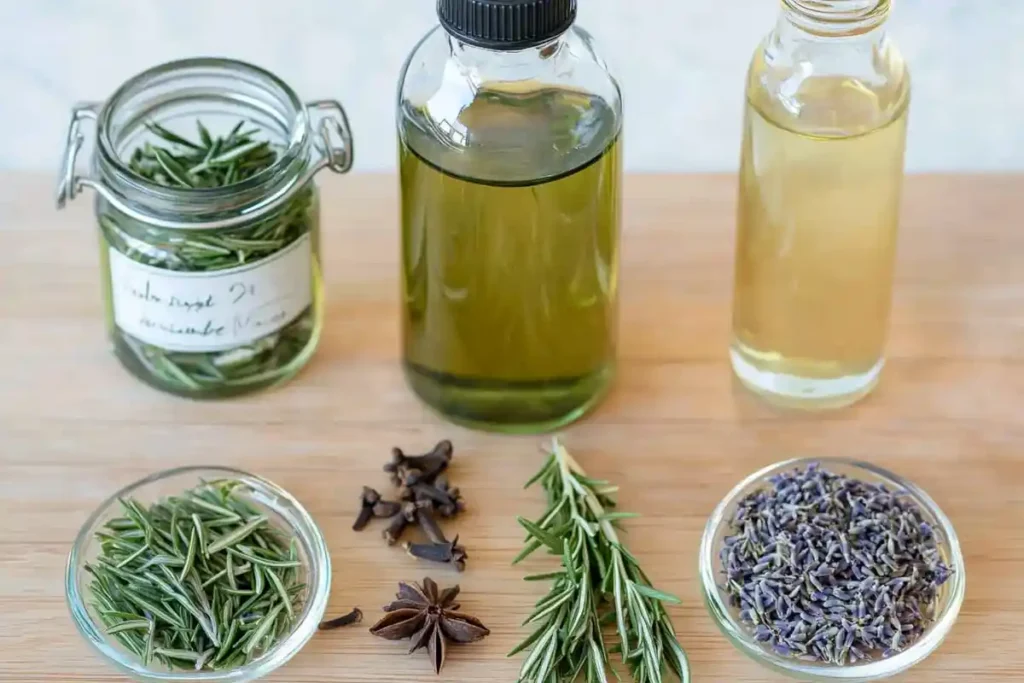
Rosemary Water with Essential Oils
If you’re looking to elevate your rosemary water recipe, adding essential oils is a fantastic way to customize its benefits. Essential oils can address specific concerns, from scalp health to relaxation.
Ingredients:
- 2 cups distilled water
- 3–4 rosemary sprigs
- 5–7 drops of lavender essential oil (for relaxation)
- 5–7 drops of peppermint essential oil (for scalp stimulation)
Instructions:
- Follow the basic rosemary water recipe steps to prepare the infusion.
- Once cooled, add your chosen essential oils.
- Stir gently to mix.
- Store in a glass spray bottle.
Best Use: Spray directly on the scalp or use it as a light mist for your hair before styling.
Why it works: Essential oils not only enhance the fragrance but also bring their own set of antimicrobial and soothing properties.
Rosemary Water with Cloves
Cloves are packed with antimicrobial and anti-inflammatory compounds, making them a perfect companion to rosemary water.
Ingredients:
- 2 cups distilled water
- 3 rosemary sprigs
- 1 teaspoon of whole cloves
Instructions:
- Boil water and add both rosemary sprigs and cloves.
- Simmer for 20 minutes.
- Cool and strain the mixture.
- Store in a sterilized spray bottle.
Best Use: Use this mixture directly on the scalp or as a clarifying rinse after shampooing.
Why it works: Cloves add an extra layer of scalp cleansing and promote healthier hair follicles.
Infused Rosemary Hair Mist
For an on-the-go refresher, a rosemary hair mist is both practical and luxurious.
Ingredients:
- 1 cup rosemary water (pre-prepared)
- 1 teaspoon rose water
- 2 drops of tea tree essential oil
Instructions:
- Combine all ingredients in a small spray bottle.
- Shake well before use.
- Mist lightly over your hair and scalp throughout the day.
Best Use: Keep it in your bag for a quick hydration boost.
Why it works: Rose water adds hydration, while tea tree oil keeps the scalp clean and free from buildup.
Rosemary Water for Skin Care
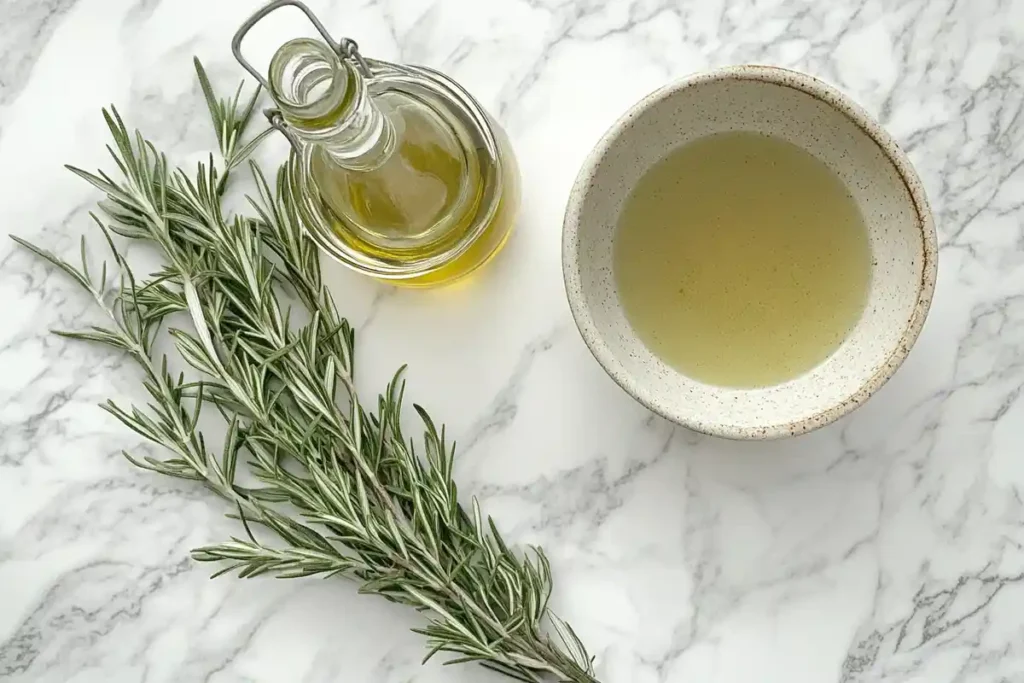
Rosemary Water for Facial Skincare
While rosemary water is celebrated for its hair benefits, it also works wonders for your skin. Its antioxidant and anti-inflammatory properties make it an excellent addition to your skincare routine.
Key Benefits for Skin:
- Reduces redness and irritation.
- Helps tighten pores.
- Provides a natural glow.
- Balances oily skin.
Using Rosemary Water as a Facial Toner
A rosemary water toner is perfect for maintaining clear and refreshed skin.
How to Use:
- Cleanse your face with a gentle cleanser.
- Pour a small amount of rosemary water onto a cotton pad.
- Dab gently across your face, focusing on oily zones.
- Allow it to air dry before applying moisturizer.
Best Use: Use twice daily—morning and night—for optimal results.
Why it works: The antimicrobial properties of rosemary water help reduce acne-causing bacteria, while its antioxidants fight environmental stressors.
Rosemary Water for Oily and Acne-Prone Skin
If you’re struggling with oily skin or frequent breakouts, rosemary water can be your skin’s new best friend.
DIY Acne Spray:
- Mix 1 cup of rosemary water with 2 teaspoons of witch hazel.
- Pour into a spray bottle.
- Spritz on your face as needed.
Why it works: Witch hazel adds an extra layer of oil control, while rosemary works on inflammation and bacteria.
Soothing Skin Irritation with Rosemary Water
For itchy, irritated, or sunburned skin, rosemary water can provide quick relief.
How to Use:
- Soak a soft cloth in chilled rosemary water.
- Apply as a cool compress on the affected area.
This method soothes inflammation and accelerates healing.
For more insights into rosemary’s dermatological benefits, explore this guide from Verywell Health.
Frequently Asked Questions (FAQs)
Can I spray rosemary water on my hair every day?
Yes, you can, but moderation is key. Start with 2–3 times a week and observe how your scalp reacts. Overuse might cause dryness in some individuals.
What to mix with rosemary water for hair growth?
You can mix cloves, lavender essential oil, or even peppermint oil to enhance rosemary water’s benefits for hair growth.
How long does it take to boil rosemary water?
The ideal boiling time is about 15–20 minutes. Allow it to simmer gently for the best infusion.
Can I store rosemary water at room temperature?
It’s best to store it in the refrigerator. At room temperature, its shelf life decreases significantly.
How long does rosemary water last?
When refrigerated, rosemary water stays fresh for up to 1–2 weeks.

